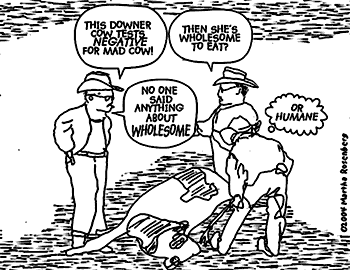|
Health �Texas has had one
variant CJD case,� the Texas Department of State Health Services Infectious
Disease Control Unit assures the public on its web site after a November mad
cow scare. �Investigators have concluded that the patient was a former resident
of the UK where exposure was likely to have occurred.� But that�s not what
the press says. Her own husband blamed the calf valve that was surgically placed in her
heart in 1979. �She had been carrying around bovine material for 20 years,�
said Mack Gore. Parents of Karnack, Texas, Green Beret Sgt. James Alford also believed he
had �the �variant� form of CJD caused by eating brains or nervous system tissue
from an infected cow,� said the AP when he was diagnosed with CJD in 2003 while
in the service. �They worry he may have got it from eating sheep brains locals
served to soldiers as an honor in Oman,� said the AP. Texas, like other states and the federal government dreads an outbreak of
variant Creutzfeldt-Jakob Disease
(CJD), the human brain disease caused by eating cows with mad cow disease. Not only can variant CJD spark panic in hospitals, health care settings
and mortuaries, it can wipe out the US beef industry in days. Remember what
happened to US beef exports when the US�s first mad cow was discovered in
Washington State in 2003? No wonder state and federal health agencies continue to protect the
identity of the Texas farm where the first domestically produced steer with Bovine
Spongiform Encephalopathy (BSE), a.k.a. mad cow disease, was raised in 2005. Why should a meat operation suffer just because it risked the lives of
people who ate its product? Why shouldn�t it be able to continue selling its wholesome products? Nor did Texas officials release names when a herd of 1,000 head of cattle
�in Texas� were quarantined and 46 carcasses tested for mad cow in 2001 after
eating banned animal meal that contained meat and bone. Who ate those wholesome
products? �This is not a public health issue, it is a violation of an FDA rule, and
the rule is a precautionary rule,� said Dr. Konrad Eugster, executive director
of the Texas Veterinary Medical Diagnostic Laboratory at the time -- using the
same wording officials used earlier this year when meat at risk for mad cow
disease from the Hallmark Meat Company was found in federal school lunch
programs. Oops. Despite the three locations, the Texas Department of State Health
Services says they have had more than six CJD cases since 2000. Sporadic CJD
comes in clusters? Texas authorities say a November scare about the source of a
hospitalized Amarillo woman�s disease is unfounded. In fact, Ted McCollum, beef cattle specialist with the Amarillo office of
Texas AgriLife Extension, was so sure it was nothing, he called the woman�s
case �sporadic� before tests were even done -- perhaps to quiet tumbling beef
futures markets at the Chicago Mercantile Exchange. Of course Texas is not the only state in High Denial. First reports of the death of the former mayor of Buffalo, NY, James D.
Griffin, from CJD by local TV stations in May vanished from the Web until
resurfacing in November, presumably after the window of hysteria had closed. But Texas has the parallel problem of
venison which is also considered unsafe because of chronic wasting disease,
the deer version of mad cow, which Texas spreads through �hundreds of
deer-breeding facilities [which have] have sprung up in the state to feed the
interest in building bucks with bigger antlers,� according to the Houston
Chronicle. (Why is Texas breeding deer if there is a deer population problem? Good
question.) Like the beef industry, Texas doesn�t want to risk its �multi-billion
dollar hunting industry,� as the Texas Parks & Wildlife Commission refers
to it, because of a mere food scare -- so it assures the public the venison is
safe. Especially when the animal doesn�t look sick -- and you bone the meat
away from the spinal cord, spleen and brain. Unfortunately, venison was not safe for Wayne Waterhouse and James Botts
of Chetek, Wisconsin, and Roger Marten of Mondovi, Wisconsin, who all developed
rare brain diseases after wild game feasts and died in the 1990s. Nor did it seem to be safe for the �three unusually young patients with
CJD who regularly consumed deer or elk meat� written up in an article in the
October 2001 issue of the Archives of Neurology. Nor had any of them visited the UK. Copyright © 1998-2007 Online Journal Email Online Journal Editor |
